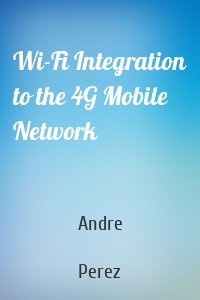Andre Perez
4 кн.
Mobile Networks Architecture
This book explains the evolutions of architecture for mobiles and summarizes the different technologies: – 2G: the GSM (Global System for Mobile) network, the GPRS (General Packet Radio Service) network and the EDGE (Enhanced Data for Global Evolution) evolution; – 3G: the UMTS (Universal Mobile Telecommunications System) network and the HSPA (High Speed Packet Access) evolutions: – HSDPA (High Speed Downlink Packet Access), – HSUPA (High Speed Uplink Packet Access), – HSPA+; – 4G: the EPS...
| Автор | Andre Perez |
Voice over LTE. EPS and IMS Network...
Voice over LTE (Long Term Evolution) presents the mechanisms put in place in 4G mobile networks for the transportation of IP packets containing voice data and telephone signaling, as well as the technologies used to provide a telephone service in the IMS (IP Multimedia Sub-system) network. Despite the difficulty connected to the handover of the 4G network to the 2G/3G network, a telephone communication will not be established on the 4G network. This book analyzes the technologies that have been...
| Автор | Andre Perez |
IP, Ethernet and MPLS Networks. Res...
This book summarizes the key Quality of Service technologies deployed in telecommunications networks: Ethernet, IP, and MPLS. The QoS of the network is made up of two parts: fault and resource management. Network operation quality is among the functions to be fulfilled in order to offer QoS to the end user. It is characterized by four parameters: packet loss, delay, jitter or the variation of delay over time, and availability. Resource management employs mechanisms that enable the first three...
| Автор | Andre Perez |
Wi-Fi Integration to the 4G Mobile...
The adoption of smartphones has had as a corollary the use of services that require streaming, such as video streaming, which is a constraint for the 4G mobile network. The integration of the network of Wi-Fi hotspots deployed by the operators adds capacity to the 4G mobile network. The use of Wi-Fi technology in carrier networks is the result of developments coordinated by the IEEE, WFA and WBA standardization bodies. For its part, the 3GPP standardization body has been working to integrate...
| Автор | Andre Perez |





